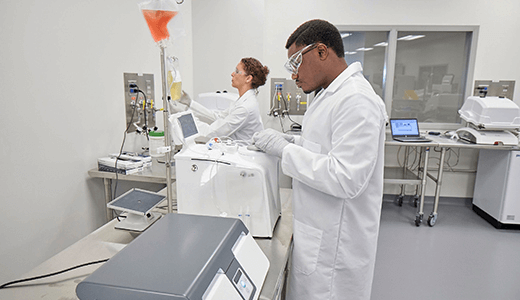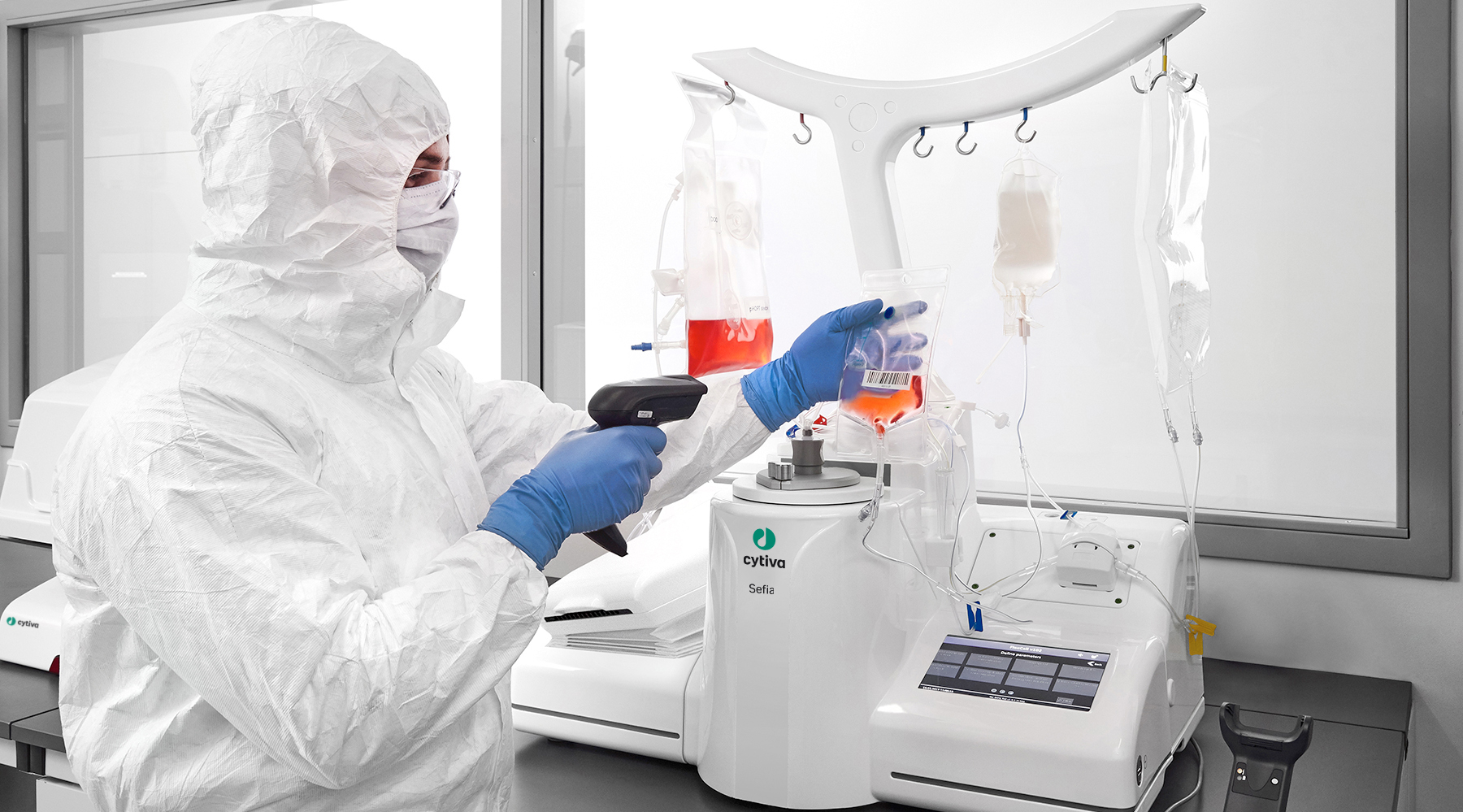By Aurélie Mounier, Security of Supply Program Leader, and George White, GM Product Management Cell & Gene Therapy, Cytiva
In the biopharmaceutical industry’s long-standing battle against cancer, CAR T cell therapies have proven to be an effective tool to treat the global killer. Recognition across the industry of their potential has driven many companies to invest R&D efforts into bringing cell and gene therapies to market, which has led to over 1,000 of these drugs in today’s development pipeline.1 This accelerated interest has come primarily off the back of the phenomenal clinical efficacy of the two approved CAR T cell therapies on the market, Kite/Gilead’s Yescarta and Novartis’ Kymriah. Over 80 percent of lymphoma patients who received Yescarta or Kymriah have seen either a significant reduction in the extent of their cancer or have gone into remission.2
Fig 1. Cytiva’s VIA Freeze liquid nitrogen-free controlled-rate freezers is cryopreservation solution, which means that cells can be stored and transported safely in right conditions. Safe transportation has been on challenge for the industry
However, major challenges in manufacturing cell and gene therapy products were not addressed, including a lack of automation, outdated analytics, and an immature supply chain with the first approved cell therapies accelerated path to the market. The latter is especially concerning, due to the vast difference between the patient impact of a supply chain interruption for a traditional biologic versus a cell and gene therapy. For example, although a batch of a traditional biologic medicines lost to errors or contamination typically can be costly, it often does not create a major interruption in supply. Pharmacies still have drugs in stock, and the manufacturer is able to manufacture another batch in its place. While the drug company faces lost costs and resources, the patient rarely sees an impact in terms of access to the drug they need. With cell and gene therapy, though, each batch is produced for one patient. If something happens to it during manufacturing, the patient impact could be as serious as death.
Therefore, building an adequate supply chain with the necessary equipment and protocols is critical for companies pursuing these life-saving drugs. Cytiva realized the importance and urgency of this need and implemented a Security of supply program, including business continuity and supplier risk management initiatives to better understand and reduce supply base risks, thereby ensuring therapy availability for their customers’ patients.
What challenges threaten the success of cell and gene therapy?
With competition growing in the cell and gene therapy market, safely progressing through the clinical phases at a good pace in order to achieve first-to-market goals is crucial. There are considerable cost pressures, though, as companies must secure the capabilities necessary to be successful, whether that is through building them in-house or through outsourcing. This includes staffing, which is challenging due to the limited availability of specialized expertise and experience in the cell and gene therapy space. Manufacturing technology also becomes an issue, as today’s equipment is not fit-for-purpose, making it necessary to leverage what currently exists and adapting that for the targeted therapy. In addition, many of the processes in cell and gene therapy are manual, which slows down production and, most importantly, delivery back to the patient of what is often a last resort treatment.
Fig 2. The gene-modified cell therapy and gene therapy therapeutic market is expected to reach a combined $45 billion in 2025 with an estimated CAGR of 83% between 2019 and 2025. The rapidly growing market means that the gaps in the supply chain need to be addressed efficiently. (Source #3)
Sales and operation planning and forecasting are also often overlooked by cell and gene therapy manufacturers. Drug companies know they must identify the anticipated supply and demand of a product, but they may not realize how important it is for their supplier to properly plan and size their manufacturing so that the supply matches the demand. Short-term considerations include not just production planning and fulfillment but also supplier and inventory management. Many do not want to, or cannot, hold a stock of supplies, for example, due to limited cash on hand and/or lack of storage space, and it is difficult to know when the product will be used.
Several supply chain interruptions over the last decade have highlighted the need for a secure supply chain in bioprocessing. For example, the 2010 tsunami in Japan created major supply issues for Cytiva when it disrupted the supply of the single-sourced, critical raw material used in the company’s chromatography resin called Sephacryl of which customers used in the manufacturing of registered biopharmaceuticals. The industry also had to deal with the fallout of the raw material scandal with Heparin, as well as trade tensions between the US and China. Even though the Heparin crisis was not connected to Cytiva, the incident was an eye-opener for the whole industry and Cytiva took major steps to implement a data-driven approach to understand and address the risks manifested in a drug supply network.
Now, with the gene-modified cell therapy and gene therapy therapeutic market expected to reach a combined $45 billion in 2025 with an estimated CAGR of 83% between 2019 and 2025,3 Cytiva recognized the need to address gaps in the supply chain for these products as well. An effort was made to increase understanding of what was needed to identify its customers’ supply challenges and risks so they could find the best solution to avoid and reduce them. In the end, the goal is to become a trusted partner to the cell and gene therapy manufacturers through increased transparency within the Cytiva supply chain.
Anticipating, investing, and securing
Addressing supply gaps in cell and gene therapy required a thorough understanding of those gaps, significant investments across the organization to fill them, and action to ensure Cytiva can serve as a long-term partner. For example, Cytiva is building a new, 7,360-square-meter facility in Grens, Switzerland, in the new Signy Park, for the manufacture of single-use kits for the Sepax™ and Sefia™ cell processing systems. The Grens facility adds five times the manufacturing capacity Cytiva currently has in Switzerland. Nemaco, a Dutch-Swiss based developer that specializes in the realization of made-to-measure buildings for multinational corporations, will design and build the new facility, which will be customized to meet specific business needs and scale with industry growth.
In addition to its manufacturing capabilities, the new site will house a Center of Excellence that will feature advanced cell and gene therapy manufacturing facilities and also serve as a base for European customer trainings and educational initiatives as well as support a growing R&D team and subject matter experts. The Grens facility will meet global regulatory requirements and is expected to be fully operational in 2022. Cytiva is also focusing on implementing efficient plans and strategies to reduce risks and costly downtime.
Fig 3. Cytiva upcoming manufacturing facility in Grens, Switzerland, will focus on the manufacture of single-use kits for the Sepax™ and Sefia™ cell processing systems. Intended to secure the capacity Cytiva’s cell and gene therapy customers need, the Grens facility adds five times the manufacturing capacity Cytiva currently has in Switzerland. The facility is expected to be fully operational in 2022.
Cytiva’s key production facilities worldwide for the bioprocess business are all ISO 22301 certified, which ensures an improved ability to manage disruptive incidents and manufacturing continuity based on site risk assessment, local requirements, and on Cytiva’s business management framework. With Cytiva’s plan, the measures and strategies for the critical resources identified depends on the nature of the resource. For example, if a fire were to occur at a supplier’s warehouse that stores raw materials, the disruption could lead to long delays before manufacturing can resume. The company’s manufacturing facility in Eysins for the cell and gene therapy business has business continuity plans within the framework of the ISO 22301. As a part of these plans, different risks are being evaluated, and mitigation plans will be put in place. Steps have to be taken to secure each phase in the supply chain, from ordering raw materials until the shipment arrives to the customer.
Supplier risk management within Cytiva also helps mitigate risks in the sourcing of raw materials that could potentially result in delivery disruptions. That is why significant resources have been invested in mitigating supply risks while using a structured approach to prioritization. Cytiva’s teams work closely with its partners in sourcing and supply chain to drive supplier risk management as a key strategic program. Risk mitigation actions, such as adjusting inventory levels of raw materials/intermediate products and long-term supplier contracts, are taken, as well as investing in second supplier programs to identify and, in specific cases, implement in the manufacturing processes.
Looking forward
These initiatives are just some of the ongoing efforts being made at Cytiva to secure supply for its cell and gene therapy customers. Agility in the face of changing needs across the industry, while maintaining regulatory compliance is a vital characteristic of any supplier in today’s industry. Suppliers must remain receptive and open to feedback and work with their customers and the regulators to ensure they are making investments that drive efficient and timely delivery of these therapies. Experience in bioprocessing and a track record of uninterrupted, high-quality supply also facilitates transfer of a successful program into the cell and gene therapy space. Without these key attributes, drug companies pursuing this exciting but challenging field may face issues that could derail their manufacturing supply, threatening access to life-saving drugs to the patients who need them.
References
- Srivastava, Sanjay. (February 2020). Cell and gene. How cell And gene therapy is transforming healthcare.
- Cleveland Clinic. (January 2020). CAR T-Cell therapy
- GlobalData Consensus Forecast (January 2020)

